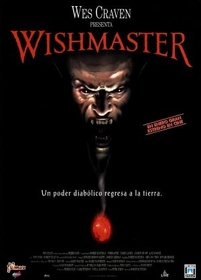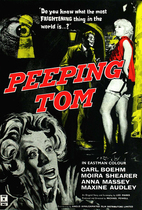Our editor-in-chief Nate Yapp is proud to have contributed to the new book Hidden Horror: A Celebration of 101 Underrated and Overlooked Fright Flicks, edited by Aaron Christensen. Another contributors include Anthony Timpone, B.J. Colangelo, Dave Alexander, Classic-Horror.com's own Robert C. Ring and John W. Bowen. Pick up a copy today from Amazon.com!
Wishmaster (1997)
Wes Craven's Wishmaster is darkly and nihilistically marvelous, an extremely enjoyable horror fantasy, even though it is heavily indebted to its influences at times as it treks through Evil Genie Land.
Beginning with a great sequence set in ancient Persia and showing the destructive power and tendency of the djinn (the Wishmaster/genie of the title), Wishmaster quickly moves to present day America. Robert Englund (the actor who portrayed Freddy Krueger) is an extremely wealthy collector of art and ancient artifacts and has imported a statue from Persia that unknowingly contains a jewel that is the key to awakening the djinn. After an accident, the jewel is revealed, stolen by a dockworker, and makes its circuitous way to our heroine.
The djinn (the term is also plural) are the satanic version of the genie legend. As a species, the djinn were created somewhere between angels and humans, and live in a kind of purgatory--in between worlds. This is explained in a titled prologue that, unlike many similar examples in other films, doesn't seem out of place and adds to the atmosphere of the film. The djinn' goal is to populate the earth, and unfortunately, humans are in the way. In line with genie folklore, they have to grant wishes to exercise their power, but their power is unlimited and they have a mean streak. That means it's horror movie time.
While officially called Wes Craven's Wishmaster, Craven didn't have much to do with the finished product. Attached as an "executive producer" largely as a side effect of director Robert Kurtzman and effects company KNB's presence (Kurtzman was a KNB'er before he moved on to directing), Wishmaster was really Kurtzman and producer Pierre David's baby. Apparently, Craven did stop by the set to go over storyboards and glance at dailies, but calling it Wes Craven's Wishmaster is a bit misleading.
Nevertheless, Craven might as well have been fully involved as a director--Kurtzman does that good of a job with the material. For the most part, Wishmaster holds its own against any of the Nightmare on Elm Street movies in terms of quality, atmosphere, hardcore modern horror, etc. It does slow down slightly in one short establishing section (when we're first introduced to the character of Alexandra Amberson up until the jewel reappears), but I suppose a film has to have some "normal" expositional dramatic scenes. That it slows down here a bit, however.
For most of the film, the focus is understandably on the titular djinn. Actor Andrew Divoff plays him with a sly, sinister aplomb that should cause him to receive many future offers. All the performances in Wishmaster are good, and there is remarkable chemistry between some of the actors. Chiefly and importantly, there is great chemistry between Divoff and Tammy Lauren (who plays Amberson). Of note to horror fans, there are lots of great cameos in Wishmaster (and of course the aforementioned Robert Englund). Kane Hodder -- Jason Vorhees in many of the Friday the 13th films--plays a security guard. Tony Todd -- the Candyman -- is a bouncer/bodyguard at Englund's house. Reggie Banister, the ice cream guy from the Phantasm films, is an ill-tempered drug store owner. And speaking of Phantasm, Angus Scrimm -- the Tall Man -- does some narration here. Another notable is Buck Flower, a bit actor in more than 80 films -- mostly horror, who plays a homeless man.
The cameos aren't just "walk-throughs." They're well acted and important to the development of the Wishmaster character. And they're fun -- most of the cameo actors, and Robert Englund, are usually on the other side of the evil deed coin, and they're usually evil dead doers who are indestructible. It's fun to watch them be mortal again.
But as good as the acting is, the effects are just as much a star, and deservedly so. From the first big payoff in the initial 10 minutes until the end, the effects team does a top-notch job--combining prosthetics, make-up, props and computer graphics into a seamless, entrancing, beautifully gory whole. The "dispatch methods" for characters are extremely creative, pleasingly graphic, and do wonders in adding to the nihilistic nature of the Wishmaster -- it's exactly what the film called for.
Criticisms might be lobbed against the "inside the jewel" sequence because of its resemblance to Clive Barker's Hellraiser series, but I wouldn't say at all that Wishmaster "rips off" Hellraiser, and interestingly, Wishmaster scripter Peter Atkins also wrote Hellraiser II, III, and IV (Bloodline). The Hellraiser movies are among my favorite films of all time, and I don't like blatant copying of anything else. Yet in light of this, the "inside the jewel" sequence of Wishmaster was one of the highlights, in my opinion.








